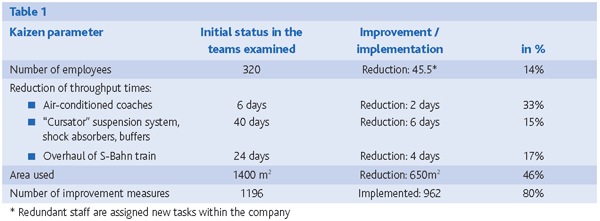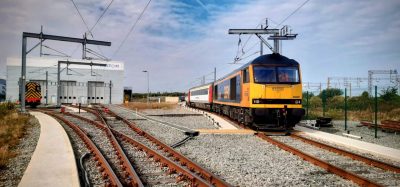The Kaizen method for SBB
Posted: 28 July 2006 | | No comments yet
Rolling stock maintenance at SBB AG has been affected by a number of trends: increasingly fierce competition, rising pressure on costs, Europe-wide overcapacity, increasingly heavy use of rolling stock with each timetable change, and ever shorter idle periods. Against this backdrop, there is a pressing need to deploy existing resources more efficiently and thereby improve productivity. SBB Passenger Traffic has set itself the goal of raising productivity at Operating Maintenance by 20% within three years and to shorten rolling stock throughput times by 30%.
Rolling stock maintenance at SBB AG has been affected by a number of trends: increasingly fierce competition, rising pressure on costs, Europe-wide overcapacity, increasingly heavy use of rolling stock with each timetable change, and ever shorter idle periods. Against this backdrop, there is a pressing need to deploy existing resources more efficiently and thereby improve productivity. SBB Passenger Traffic has set itself the goal of raising productivity at Operating Maintenance by 20% within three years and to shorten rolling stock throughput times by 30%.
Rolling stock maintenance at SBB AG has been affected by a number of trends: increasingly fierce competition, rising pressure on costs, Europe-wide overcapacity, increasingly heavy use of rolling stock with each timetable change, and ever shorter idle periods. Against this backdrop, there is a pressing need to deploy existing resources more efficiently and thereby improve productivity. SBB Passenger Traffic has set itself the goal of raising productivity at Operating Maintenance by 20% within three years and to shorten rolling stock throughput times by 30%.
SBB has a passenger fleet of 330 main-line locomotives, 63 multiple units, 251 self-propelled cars, 456 driving trailers, 2,650 passenger coaches and 58 shunting locomotives. Each day, 1,143 long-distance trains cover a total of 190,752km and 3,212 regional-service trains cover 144,755km.
With 1,900 employees, Maintenance operates two rolling stock works, one repairs depot and nine preventive maintenance depots. The main focus of work is on:
- Maintenance and cleaning of 600 passenger vehicles per day
- Overhauls, modifications and refits for approximately 120 vehicles a day
- Repairs to approximately 40 temporarily decommissioned vehicles per day
- Approximately 550 repairs per day to rolling stock currently out of use
SBB Operating attaches great importance to developing a performance-driven corporate culture based on the following management principles:
- The customer comes first
- Work is to the required standard and at the lowest possible price
- Professionalism at all levels
- Mutual respect
- Contribution to profitability
The target: to improve productivity
In 2004, Passenger Traffic division trains ran a total of 109.3 million train-kilometres. In 2005 – after the launch of Rail 2000 in December 2004 – this figure rose by 14.9% to 125.5 million train-kilometres. SBB Passenger Traffic invested approximately CHF 700 million in 2005, of which CHF 405 million went into rolling stock. Despite the record number of train-kilometres, the division’s financial result fell short of the 2004 figure. This was due to the higher costs generated by the expanded service, additional train-path charges, a massive increase in rolling stock usage, and higher maintenance costs. Passenger Traffic thus posted a profit of CHF 78.6 million for 2005, down from CHF 152.2 million in the previous year. Since the cost situation is not set to change in the near future, this factor is likely to continue exerting massive pressure on the results in the years to come. Rigorous efforts to slash costs and raise productivity are thus being pursued. All areas within the Passenger Traffic division are affected by this process. Maintenance aims to bring about a sustained increase in productivity by at least 20%, and to reduce rolling stock throughput times by 30% within three years. Applying Kaizen processes will eliminate waste and bring about lasting improvements.
The Kaizen method
SBB Passenger Traffic is facing up to the competition and has chosen the Kaizen method to meet its target of a sustainable improvement in productivity. Kaizen, which has been used and perfected in the Toyota Production System for more than 30 years, means “improving what is good”. It involves methods and tools for systematically identifying and eliminating waste by focusing available resources on value added activities. The aim is to continue developing SBB’s 100-plus years of experience in rolling stock maintenance in small steps, thus adapting it to the competitive situation now prevailing. With dedicated training and implementation of Kaizen methods and tools, productivity gains of 25-30% are possible. Kaizen implies a culture change, calls for new mindsets, and requires the full support of all management. Only then can the ongoing process of improvement be achieved.
Background
A history going back more than 100 years has given rise to ingrained structures. A process of continuous improvement is scarcely in evidence, and not everyone is aware of the need for change in the interest of improving processes. Processes often involve long throughput and idle times, and the few key figures that are available are rarely understood. Standards are mostly lacking, and processes are to a large extent shaped by the experience of senior employees. Staff are insufficiently trained in the systematic application of methods and tools to improve processes. Added value and waste are not properly understood.
The road to success
Developing an active culture of continuous improvement is a considerable challenge. Kaizen teams were formed by trained in-house coaches to implement a five-stage ‘5S’ process. Each Maintenance employee attends a three-day course covering the five stages, namely:
- Simplify your workplace
- Maintain cleanliness
- Put everything in the right place
- Standardise
- Maintain self-discipline
Initially, the five stages are conveyed theoretically, but then each 5S participant implements them at his or her workplace straight away.
With this method, short-term achievements are immediately apparent. To bring about substantiated productivity rises, productivity workshops are also organised. At these five-day events, a Kaizen team consisting of a coach, a team leader and individual team members analyse in detail the tasks and processes of a production team at the site in question. Value added activities are distinguished from non-value added activities (i.e. waste) by means of observation, time recordings and analysis. Waste is defined as surplus production, excessive inventories, all types of internal transportation, waiting time, unnecessary movements, and defective output. At the end of the workshop, binding output targets, as well as deadlines for achieving them, are agreed with team members. The results and the agreed targets are then presented to site management. Other areas covered by the workshops are:
- Standardisation for improved quality assurance
- Developing, implementation and visualising team-oriented statistics
- Training team leaders in Kaizen methods and professional production management (5S, order and cleanliness, standardisation, visualisation, tracking waste, improvement cycle)
- Team-building and leadership training
Status of work
The Kaizen project was started at the Olten works (headcount: 500) in January 2005. Introduction of the method at the Yverdon works (headcount: 250) began in October 2005 and in February 2006, the Zurich repair depot (headcount: 250) adopted the Kaizen approach. This gradual phasing-in made it possible to build up sustainable Kaizen teams and train coaches at each location.
Initial results
The initial results are gratifying. Potential productivity gains of at least 20% were identified at the Olten and Yverdon works and the Zurich repair depot. The current figures from the Olten works for the period January 2005 – May 2006 serve as an example (see Table 1).
Going forward
From summer 2006 onwards, the process will be extended to the other service locations (preventive maintenance and repair), namely: Geneva, Lausanne, Brig, Basel, Lucerne, Zurich Herdern, Oberwinterthur and Weinfelden / Rorschach. By mid-2007, Kaizen will have been introduced throughout SBB Passenger Traffic’s Maintenance operation.
That does not, however, mean that the Kaizen process will be finished, allowing everyone to return to their daily routines. Experience clearly shows that Kaizen only becomes truly effective if the “flame of continuous improvement” is carried further, thus nurturing a culture of learning and improvement throughout the company. Moreover, the successful spread of Kaizen hinges on systematic benchmarking: only by making direct comparisons with the direct competition can SBB Passenger Traffic’s Maintenance operation ascertain whether and how competitiveness and productivity are changing.


Stay Connected with Global Railway Review — Subscribe for Free!
Get exclusive access to the latest rail industry insights from Global Railway Review — all tailored to your interests.
✅ Expert-Led Webinars – Gain insights from global industry leaders
✅ Weekly News & Reports – Rail project updates, thought leadership, and exclusive interviews
✅ Partner Innovations – Discover cutting-edge rail technologies
✅ Print/Digital Magazine – Enjoy two in-depth issues per year, packed with expert content
Choose the updates that matter most to you. Sign up now to stay informed, inspired, and connected — all for free!
Thank you for being part of our community. Let’s keep shaping the future of rail together!







